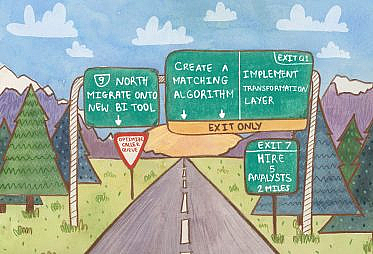People often ask for advice about building out an analytics organization – How to structure the team? What skills to hire for? Do we need engineers? What about data scientists? How big should the team be? Unfortunately, there is no easy answer to these questions, because the best analytics team is the one that best supports the organization and its specific needs. To make things even more complicated, A) different organizations have very different needs and B) your organization’s needs today will be very different from its needs in the future.
In this post I will discuss some of the different dimensions that are important to evaluate when thinking about how to structure an Analytics team.
Important Dimensions to Consider
- Ambient technical ability at the company (Is the company made up of former software engineers or former creatives?)
- Baseline level of analytic ability (what is the likelihood that a randomly selected person in the company will know how to use a pivot table?)
- Distribution and variance of analytical skills (Is there a wide variance where some teams have more skill than others?)
- Engineering support (How much dedicated engineering support can you rely on?)
- Business intelligence vs statistical learning (Are you trying to generate reports for operational measurement or build complex models to feed into your product?)
I will take a closer look at how each of these dimensions may impact the needs for an Analytics team.
Ambient Technical Ability
If your company is a software or technology company filled with software engineers (and former software engineers) then the types of work your analytics team may do will vary greatly from a company that is filled with marketers and creatives. In a company of former software engineers you can go for quite a long time sharing ipython notebooks or the output from R scripts, and you can build command-line tools and expect that people will be comfortable using them. If your company is not super software-saavy, you can expect to spend much more time building (or buying and implementing) software that has nice user-friendly GUIs.
Since most analytics work is about serving internal clients and meeting them where they are, it is important to understand how user-friendly the tools you build will need to be so that you can staff appropriately.
Baseline Level of Analytic Ability
Some companies are highly analytical, staffed by bankers and consultant-types who are extremely comfortable understanding, interacting with, and modifying complex Excel models. Some companies have a much lower level of analytical fluency where Excel pivot tables may be unfamiliar and rocky terrain. Your business partners’ analytical skill level will determine how big your Analytics team needs to be as well as the type of work the team will do.
In a highly analytical organization, the Analytics team will likely spend more time on infrastructure and tooling – providing data to our users so that they can do their own “last mile” analysis for whatever their purpose is. In this situation you likely need fewer, more technical Analysts.
In a less analytical org, the Analytics team will spend more time actually doing analyses – putting together Excel models, summarizing results in a deck, and sharing out the implications. In this situation, you likely need more, less-technical analysts (as a lot of the work is relatively straightforward “BI”).
Distribution and Variance of Analytical Skills
A very interesting situation arises when you have multiple partner teams of varying skill-levels: maybe the Acquisition Marketing team is extremely data savvy, but the Supply Chain team is not. In a situation like this you have to think carefully about how to meet the different needs of these different teams efficiently. You want to empower the Acquisition Marketing team without getting in their way, and you want to make sure that you are not leaving the supply chain team in the lurch with tools they can’t use.
This is a common problem we have observed where the “power users” on one or two teams end up being the only ones in the organization who can really make use of all of the data available, because they are the ones most often interacting with the Analytics team. It is important to think about how everyone, not just the most technically saavy, is able to leverage the tools that your building.
Engineering Support
This section likely deserves a blog post of its own, but knowing how much software engineering support you will get from the Tech team is critical to building a high-functioning Analytics organization. If the Tech team does not have an “internal tools” function and is primarily focused on revenue-generating activities (like running an e-commerce website) then you might struggle to get resources allocated to working on analytics and data projects. In this world, it may make sense to hire either hyper-technical Analysts who can build their own tools, or even hiring data-focused Software Engineers directly onto the Analytics team.
Business Intelligence vs Statistical Learning
Perhaps most importantly, it is critical to understand what the most pressing problems are for your organization. Do you need to build complex models for deep customer insights, or do you need to provide baseline reporting and business intelligence services competently? Pretty much always it is a mix of both. It is important to think about where on the spectrum your organization falls, and how that impacts your staffing decisions.
Obviously a team of Data Scientists or Statisticians with graduate degrees is going to work on very different problems than a team of BI Analysts with only a few years of experience.
Concluding Thoughts
A common mistake that I have observed too frequently happens when an organization hires a statistician as the first member of a Data team without any BI tooling or engineering support. That poor statistician ends up spending all of her time trying to write ETL (which she is learning on the job) and automate reporting tasks (often by re-inventing BI software) rather than actually doing … statistics.
While there is no magic bullet to designing the right analytics organization for your company, by being thoughtful about the actual needs of your organization and what the highest-leverage activities for an analytics team will be, you can avoid many of the common pitfalls that afflict Analytics organizations.





